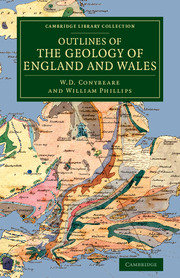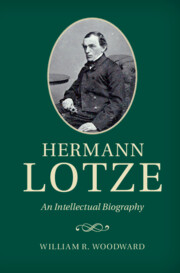Refine search
Actions for selected content:
10306 results in History of science: general interest
Part Three - The System in the Bismarck Period
-
- Book:
- Hermann Lotze
- Published online:
- 05 June 2015
- Print publication:
- 09 June 2015, pp 321-448
-
- Chapter
- Export citation
Appendices
-
- Book:
- Hermann Lotze
- Published online:
- 05 June 2015
- Print publication:
- 09 June 2015, pp 452-459
-
- Chapter
- Export citation
Postscript: Historiographic Lessons of Lotze Research
- from Part Three - The System in the Bismarck Period
-
- Book:
- Hermann Lotze
- Published online:
- 05 June 2015
- Print publication:
- 09 June 2015, pp 435-448
-
- Chapter
- Export citation

Outlines of the Geology of England and Wales
- With an Introductory Compendium of the General Principles of that Science, and Comparative Views of the Structure of Foreign Countries
-
- Published online:
- 05 June 2015
- Print publication:
- 06 November 2014

Hermann Lotze
- An Intellectual Biography
-
- Published online:
- 05 June 2015
- Print publication:
- 09 June 2015

An Experimental Inquiry into the Nature and Propagation of Heat
-
- Published online:
- 05 June 2015
- Print publication:
- 18 December 2014
- First published in:
- 1804
Phrenology, heredity and progress in George Combe's Constitution of Man
-
- Journal:
- The British Journal for the History of Science / Volume 48 / Issue 3 / September 2015
- Published online by Cambridge University Press:
- 14 May 2015, pp. 455-473
- Print publication:
- September 2015
-
- Article
-
- You have access
- Open access
- HTML
- Export citation
Richard Yeo, Notebooks, English Virtuosi, and Early Modern Science. Chicago and London: The University of Chicago Press, 2014. Pp. xvii + 398. ISBN 978-0-226-10656-4. $45.00/£31.50 (hardback).
-
- Journal:
- The British Journal for the History of Science / Volume 48 / Issue 2 / June 2015
- Published online by Cambridge University Press:
- 29 April 2015, pp. 360-361
- Print publication:
- June 2015
-
- Article
- Export citation
BJH volume 48 issue 2 Cover and Front matter
-
- Journal:
- The British Journal for the History of Science / Volume 48 / Issue 2 / June 2015
- Published online by Cambridge University Press:
- 29 April 2015, pp. f1-f2
- Print publication:
- June 2015
-
- Article
-
- You have access
- Export citation
William J. Turkel, Spark from the Deep: How Shocking Experiments with Strongly Electric Fish Powered Scientific Discovery. Baltimore: Johns Hopkins University Press, 2013. Pp. xi + 287. ISBN 978-1-4214-0981-8. £22.50 (hardback).
-
- Journal:
- The British Journal for the History of Science / Volume 48 / Issue 2 / June 2015
- Published online by Cambridge University Press:
- 29 April 2015, pp. 364-365
- Print publication:
- June 2015
-
- Article
- Export citation
Douglas A. Lorimer, Science, Race Relations and Resistance: Britain, 1870–1914. Manchester: Manchester University Press, 2013. Pp. xi + 344. ISBN 978-0-7190-3357-5. £80.00 (hardback).
-
- Journal:
- The British Journal for the History of Science / Volume 48 / Issue 2 / June 2015
- Published online by Cambridge University Press:
- 29 April 2015, pp. 373-374
- Print publication:
- June 2015
-
- Article
- Export citation
P.J. Capelotti, Shipwreck at Cape Flora: The Expeditions of Benjamin Leigh Smith, England's Forgotten Arctic Explorer. Calgary: University of Calgary Press, 2013. Pp. xxix + 269. ISBN 978-1-55238-705-4. US$41.95 (paperback).
-
- Journal:
- The British Journal for the History of Science / Volume 48 / Issue 2 / June 2015
- Published online by Cambridge University Press:
- 29 April 2015, pp. 371-372
- Print publication:
- June 2015
-
- Article
- Export citation
Kersten T. Hall, The Man in the Monkeynut Coat: William Astbury and the Forgotten Road to the Double Helix. Oxford: Oxford University Press, 2014. Pp. ix + 242. ISBN 978-0-19-870459-1. £18.99 (hardback).
-
- Journal:
- The British Journal for the History of Science / Volume 48 / Issue 2 / June 2015
- Published online by Cambridge University Press:
- 29 April 2015, pp. 380-381
- Print publication:
- June 2015
-
- Article
- Export citation
Amir Alexander, Infinitesimal: How a Dangerous Mathematical Theory Shaped the Modern World. London: Oneworld, 2014. Pp. 352. ISBN 978-1-78074-532-9. £20.00 (paperback).
-
- Journal:
- The British Journal for the History of Science / Volume 48 / Issue 2 / June 2015
- Published online by Cambridge University Press:
- 29 April 2015, pp. 362-364
- Print publication:
- June 2015
-
- Article
- Export citation
Abena Dove Osseo-Asare, Bitter Roots: The Search for Healing Plants in Africa. Chicago and London: The University of Chicago Press, 2014. Pp. viii + 300. ISBN 978-0-226-08602-6. £24.50 (paperback).
-
- Journal:
- The British Journal for the History of Science / Volume 48 / Issue 2 / June 2015
- Published online by Cambridge University Press:
- 29 April 2015, pp. 381-382
- Print publication:
- June 2015
-
- Article
- Export citation
Matthew C. Hunter, Wicked Intelligence: Visual Art and the Science of Experiment in Restoration London. Chicago and London: The University of Chicago Press, 2013. ISBN 978-0-226-01729-7. £38.50 (hardback).
-
- Journal:
- The British Journal for the History of Science / Volume 48 / Issue 2 / June 2015
- Published online by Cambridge University Press:
- 29 April 2015, pp. 361-362
- Print publication:
- June 2015
-
- Article
- Export citation
The shock of the odd
-
- Journal:
- The British Journal for the History of Science / Volume 48 / Issue 2 / June 2015
- Published online by Cambridge University Press:
- 29 April 2015, pp. 353-356
- Print publication:
- June 2015
-
- Article
- Export citation
Ruha Benjamin, People’s Science: Bodies and Rights on the Stem Cell Frontier. Stanford, CA: Stanford University Press, 2013. Pp. xv + 249. ISBN 978-0-8047-8297-5. £17.99 (paperback).
-
- Journal:
- The British Journal for the History of Science / Volume 48 / Issue 2 / June 2015
- Published online by Cambridge University Press:
- 29 April 2015, pp. 383-384
- Print publication:
- June 2015
-
- Article
- Export citation
Margaret C. Jacob, The First Knowledge Economy: Human Capital and the European Economy, 1750–1850. Cambridge: Cambridge University Press, 2014. Pp. ix + 257. ISBN 978-1-107-61983-8. £19.99 (paperback)
-
- Journal:
- The British Journal for the History of Science / Volume 48 / Issue 2 / June 2015
- Published online by Cambridge University Press:
- 29 April 2015, pp. 367-368
- Print publication:
- June 2015
-
- Article
- Export citation
Oren Harman and Michael R. Dietrich (eds.), Outsider Scientists: Routes to Innovation in Biology. Chicago and London: The University of Chicago Press, 2013. Pp. ix + 374. ISBN 978-0-226-07840-3. £24.50 (paperback).
-
- Journal:
- The British Journal for the History of Science / Volume 48 / Issue 2 / June 2015
- Published online by Cambridge University Press:
- 29 April 2015, pp. 378-380
- Print publication:
- June 2015
-
- Article
- Export citation
